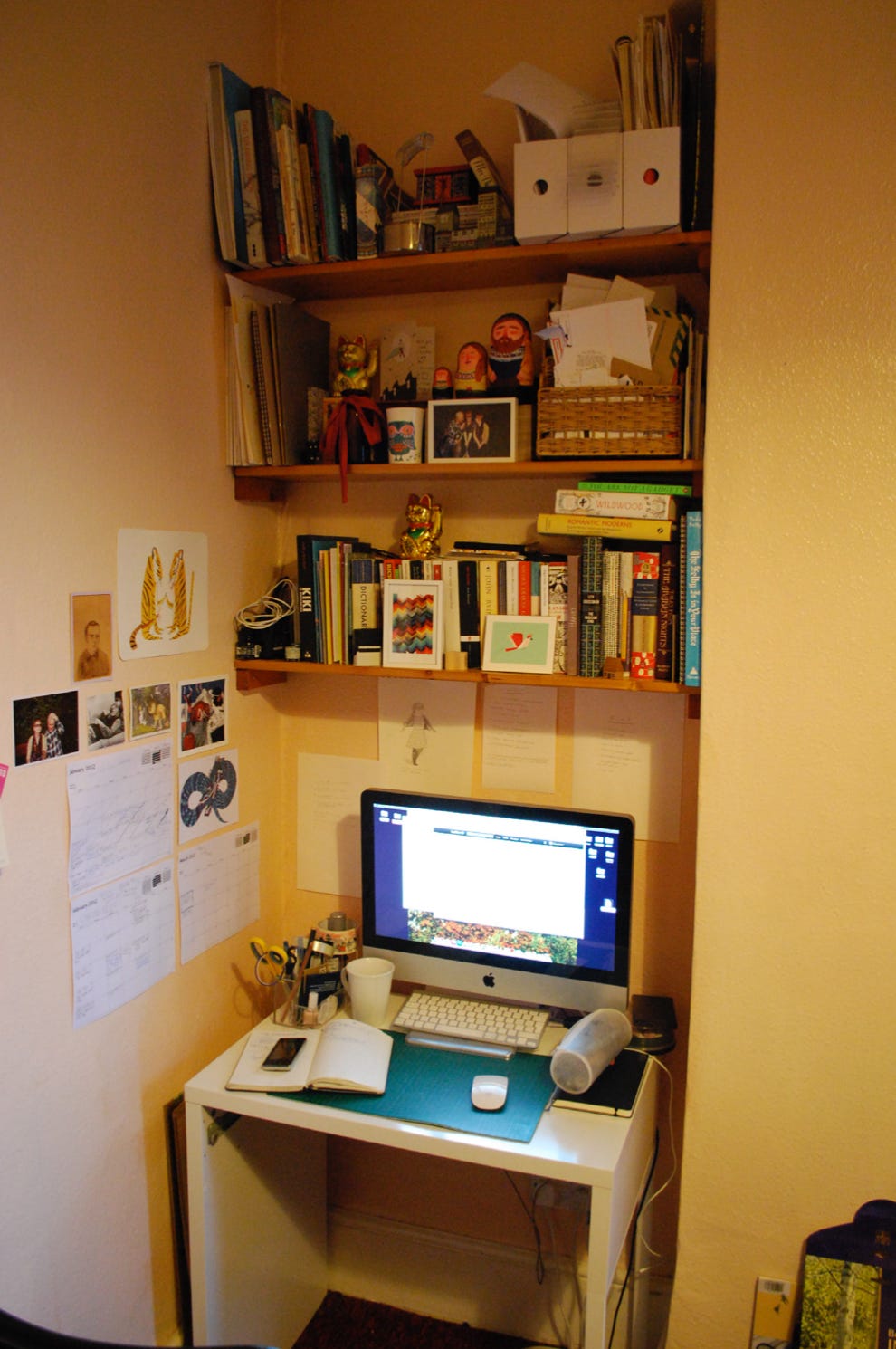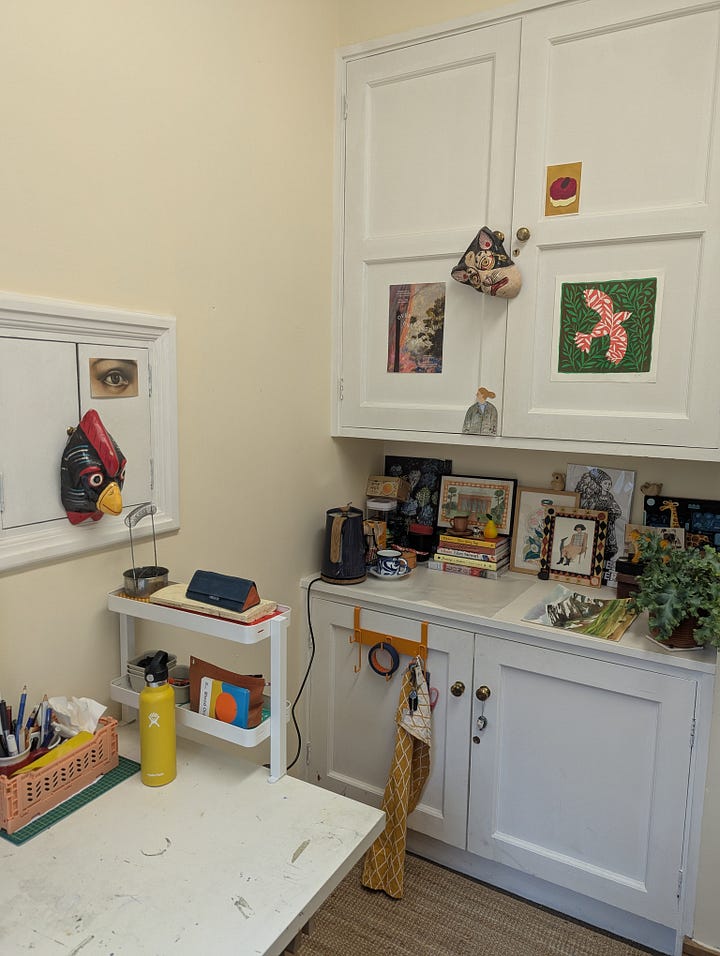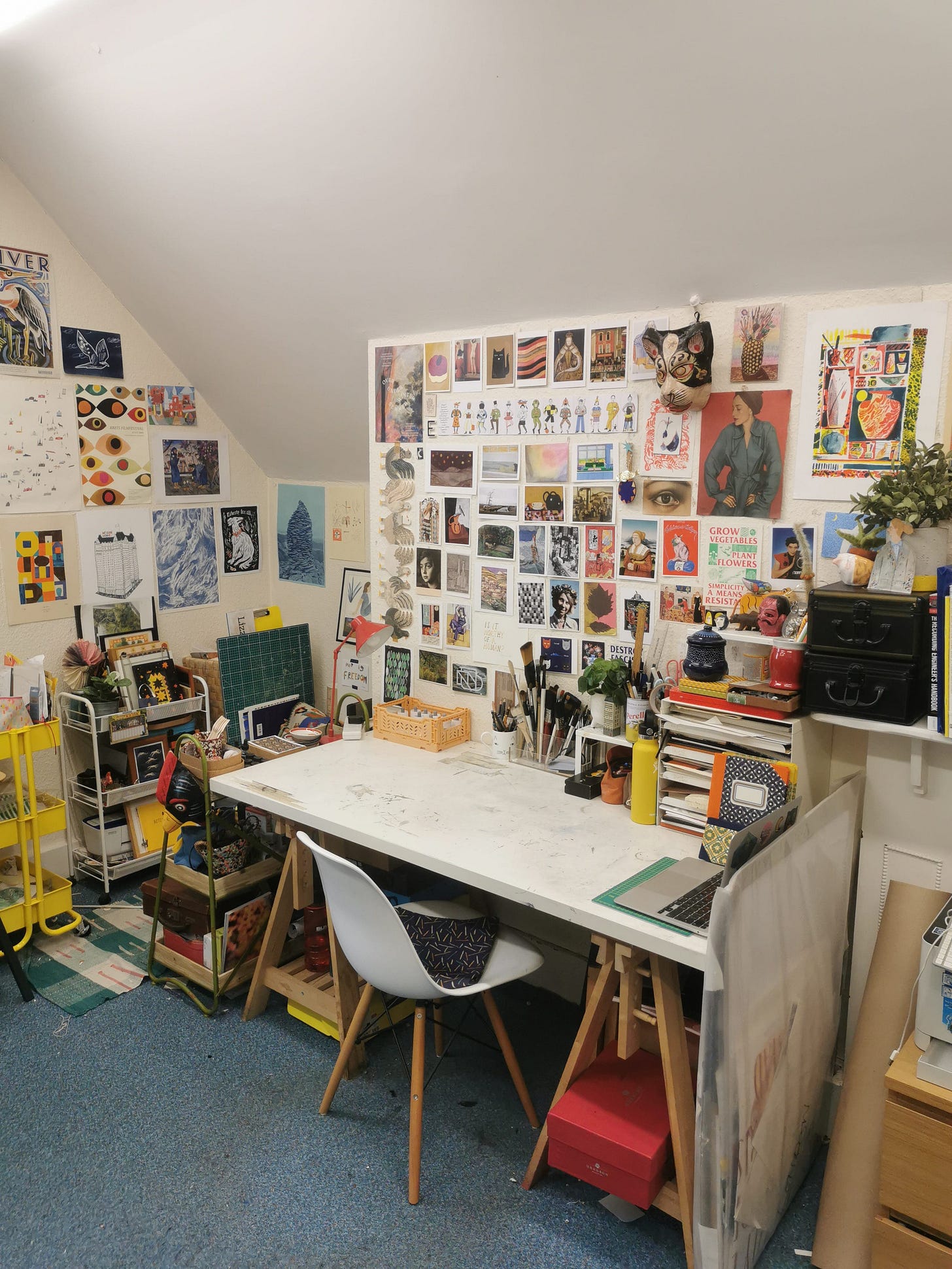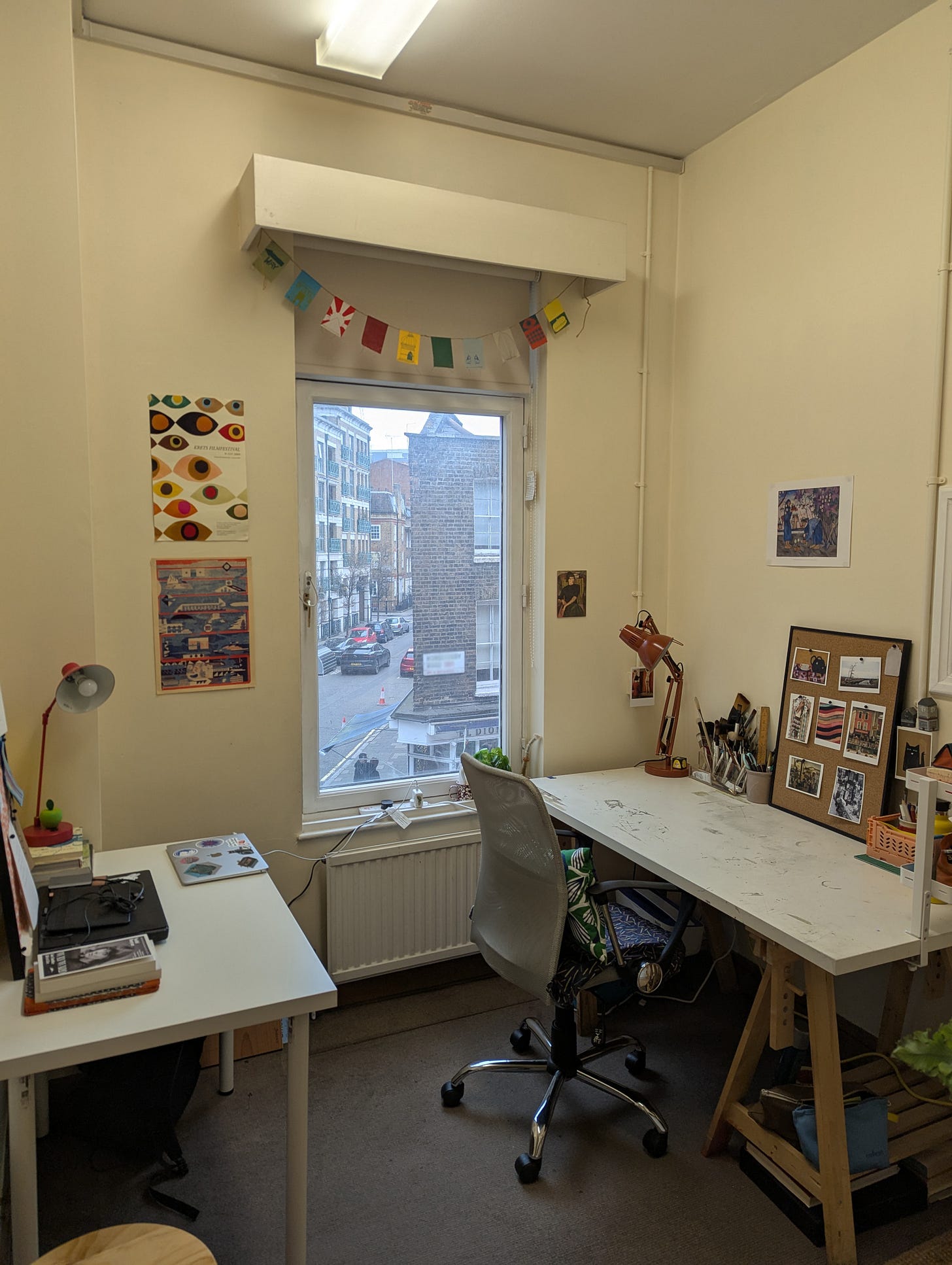I often say to my students, in the repetitive manner that comes to all tutors whether you like it or not, that drawing is really easy way of creating a portal through time. Of course its a way of recording what you see but in the process of sitting still, of looking and listening, you trap so much more on your page than just the thing that you’re drawing. Obviously this is specifically true with observational drawing. When I look at things I’ve drawn on trips, I find I can remember the exact temperature, the quality of light, the conversations I was eavesdropping on and so forth. It’s like taking a photo, except it takes longer, so it forces you to register the world around you, and the world inside you, a little more thoroughly. If you want to remember a moment, do a drawing.
It turns out its also true for the work I make in my studio. If I look at a painting from six,seven or eight years ago, I find I can remember the room, who else was there, the music we listened to (sometimes) and the time of year. Which means that, as I packed up my studio to move across the river, I found myself sifting through the last fifteen years of my life and trying to resist the sentimental lure of the past.
Being an artist means that, if you’re lucky, you have a second home; a work-home. Even if this a room in your house, or a corner of room in your house, this place is still somehow slightly separate from the rest of your life. I’ve had a few of these work-homes, at varying levels of functionality and impressiveness, and I’ve thought about them a lot in the past few weeks as I moved to a new place where, hopefully, I’ll be for some time.
This was my fourth year desk at Edinburgh College of Art. When I moved to Edinburgh for University I had a vivid idea of what a ‘studio’ should/would look like and was delighted that my first visit to the illustration studio (towards the end of my first year of Fine Art) was exactly the tatty, paint-stained, wooden-floored room I’d keenly imagined. Of course, in the time it took me to switch my allegiance from Fine Art to Illustration the course moved to a building named Evolution House, a move that was about as far from an evolution as was possible. The new building was an office. The story we heard was that the college had sold off some land to make some money, the building had been erected as a corporate office space and then the college had bought it back, because it turned out they needed the space after all.
The illustration room was big, it had that going for it at least. Three year groups could work in one room and we all had desks. As well as the desks we had corporate fixtures and fittings, grey carpets, glass walls and the nicest toilets in the whole college.
In fourth year (when this photo was taken), I remember feeling that I hadn’t gotten the array of postcards above my desks quite right. In previous years I think I’d wasted hours honing my ‘desk wall’ but it was final year and we had more pressing concerns. Looking at the chunky macbook in this photo (my most prized posession in 2009) I feel like I can smell the new plastic (which, to me, always smelt like the same plastic that wrapped books in our local library) and hear the specific click of the keys.
Anyway the best thing about a university studio is that there are other people in it and you have no say over who they are or what they’re up to. In 2009 I think there were fourteen of us in our year group and we all approached work differently. I could sit at my desk and look over the divides and see Sarah printing with lino, Kirsten doing a fiddly pencil drawing and Toby working, bafflingly to the rest of us who remained heavily paper-based, on a wacom tablet. We were so lucky to have that enormous but not-quite-right studio and to have our own individual spaces within. Students today are lucky if they get access to a room they can use every day of the week let alone their own desk.
And the toilets really were nice.
What I didn’t know when I graduated was that space would never again be as affordable to me as it was in 2009. Still, as a fledgling illustrator with no transferable skills I had very little cash to spare. So I worked in the living room of the flat I shared with Jez and, in light of some of the desks to come, it was really pretty nice. Still I was quite shockingly lonely, on a day to day basis. Even if I’d arrived in to college and not spoken to anyone, there were always people in the room. I had absolutely under-estimated the power of people in the room. What a comfort it is to hear chatter and chairs being pushed in and out and having someone tap you on the shoulder to ask ‘lunch?’.
When I look at this photo (below) I see the desk of someone who wanted things to go well. Also someone who was spending far too much time on tumblr (never again would my desk be so floral). I wanted my desk to be desirable, professional and presentable. I hadn’t really thought of it as a ‘workspace’ yet because I wasn’t really sure what my work was. I used a director’s chair that came with the flat we were renting and had my first experiences of work-related back pain. I worked on a book cover that got canned and replaced with a photographic image, I drew the clothes I wore every day, and I missed, terribly, my friends who had left Edinburgh (one of whom gave me the horrible shell owl which I love very much, still).
We’d been living in the centre of Edinburgh and, it turned out, it wasn’t really financially viable for two people in their early twenties and so we moved a bit further out and, miraculously (it would be over a decade before this happened to me again) we had a spare bedroom (below). Jez worked in a little studio behind a shop in town and when he plodded off every morning I would turn into the next room and start ‘work’.
I liked this room a lot, after all a bed right next to your desk is a useful thing to have. But I was floundering here, I didn’t know what work I should be doing and I bounced around from job to job doing a different thing every time, unclear of what people wanted from me. Twenty-three is very young to be working for yourself. I didn’t know that then of course. I felt old. Old enough anyway. But now? Now I am am baffled that I didn’t spend more time under that children’s duvet from IKEA, hiding from everything.
At some point in early 2011 there was an upheaval. Jez was offered a job in San Francisco, having known him since I was seventeen, his potential absence had a terrible, unmooring effect. I found myself looking at master’s degrees in London and the one with the cheapest/shortest application process was Central St Martin’s. In September, off I went.

The next room was a step backwards, maybe a few steps backwards. Truly the worst flat I’ve ever lived in. We would open the living room curtains to find the landlord mowing our lawn unannounced, his eyes fixed on the windows, not the lawn. One evening a cupboard fell off the kitchen wall, missing my head by a millimetre and a gas leak on the day we moved in was deemed ‘the safe amount of gas’ by the landlord, the second night the police were called downstairs because a unknown man was wandering in the garden. It was a peach painted monstrosity with deep red carpets and a emerald green leather sofa; one of those places that you have to summon a reserve of energy to power through spending time in and that when you leave, you find thinking about it for more than a second makes your skin crawl.
London was much more expensive than Edinburgh (then, at least) and my ‘studio’ was a slim corner of my horrible bedroom (below). When I look back at the work I made here I am horrified by how scrappy and under-thought so much of it is. I think the room and the flat had a genuine effect on what I was able to do, both physically and mentally.
I did, however, spend a lot more time writing, something I’d enjoyed, always, but been afraid to engage with for fear of doing a bad job. I suppose that the fact that I couldn’t draw or paint here very easily pointed me towards other outlets that were easier in the space that I had.
It was also the time that I really discovered cafes as places to work. I read an article this morning about cafe owners growing tired of laptop users taking up space. Which is fair. However Rosie’s Cafe (in Brixton Village, defunct) was the best writing space I ever had.

2012 and four artists in one house (Ping, Eleni, Otto and I) and I took a hit for the team and took the smallest (cheapest) bedroom and so my desk was in the living room. I remember doing two jobs at this desk and both were awful. Mostly I remember, very specifically, trying to finish something for my Master’s whilst my housemates watched Twin Peaks over my shoulder.
Somewhere in here, actually somewhere between the peach-walled nightmare and the living room desk I also moved into a real studio. A place I paid money for. Below is a photo, taken to accompany an interview, of that studio space. The secret here is that only half the desk belonged to me. I shared with Ping. We couldn’t afford a whole desk each and so, whilst everyone else took up a full two metres each we split our space in two and tried to work around one another.
I wanted to feel successful, I think. I certainly wanted somewhere to go, especially in the creepy-landlord-flat. We were in the dying days of internet’s creative heyday and if I had learned anything from blogs and instagram it was that studio’s were big and light and filled with plants and Anthony Burrill posters. All of which this place had.
Most of the time here I was deeply self conscious. As far as I was concerned everyone else there was a bit further down the line, even just by a year or two, they had big jobs with big clients and they all lived nearby (not an hour away, like we did), they rode bikes and could roll their trouser legs up in that way that made them hang just right, all the time.
When I think about this place I think about going to the really nice deli around the corner with Ping, buying almond tarts and being dumb and loud and silly as we walked there, relieved to be outside.
When that big shared studio closed (and Ping moved away) I moved south with Kerry. Kerry had been sat across the room from us in the big studio for a few months but, owing to terror on both sides, we’d barely spoken. What a relief it was to discover that someone else had felt as out of their depth as I had. We found a very cheap room in Peckham and had a third desk that was shared by Eleni (brilliant) and Sarah (brilliant) on different days.
This place was cold and draughty, and the toilet, downstairs, betrayed signs that someone was living in the building and not really ever washing their towels and there were fly traps in the kitchen populated with little dried-out fly carcuses of all shapes and sizes. Still, more than the big fancy place in East London, this felt, for the year or two that we were there, like ours.
(There was a a place after this but I can’t find a photo. Equally cold but with better toilets and an easily accessible sink. The only thing you need to know about that place was that it was behind a business run by a couple who hated each other and we’d get trapped in the studio in the evenings whilst they argued in the corridor outside and then we were burgled and decided to leave.)
We’re getting to the end, don’t worry. This was my last studio. I worked here for eight years and, for the most part, I loved it. It was shabby and unglamourous and up six flights of, deceptively tiring, stairs, there were definitely mice and people had a tendency to hang out directly below our window and either make very loud phone calls or urinate but it was also homely, very warm, and filled with excellent people. Unlike the enormous East London place there were only four desks, so the people I shared with (some constant presences, some short stays) became a nice little group, relaxed and friendly.
I liked the local cafe owners (and their sandwich offerings) and there were a few shops where you could get a nice birthday card and emergency gift (which is a very useful thing to have nearby). I did good work and terrible work in this room, I illustrated at least seven books there, including my next one. In 2020 I walked an hour every day (once were allowed to do that) to get to work. Opening the door to the empty room felt like the greatest gift anyone could have given me at that time.
But in the last year or so it became less practical. We moved further away for starters, the bus to get there was slow and the train, expensive. And I wanted to spend more time writing, which I struggled to do in a shared room (although I do maintain that I manage fine in cafes). I wrote a bit about this at the start of last year. I wanted a room of my own but I didn’t know if I could afford it. And then Owen spoke to Alex who said Lauren had a new studio and there was a small room next door…
And now here we are. Fourteen years after I left university I have a room of my own and a second desk to write on. The photos don’t really describe it well but oh my gosh I love it.


What was the point of all this (I specifically mean this newsletter, not the last fifteen years of my life). Well, I suppose to say that illustration, and maybe art of most kinds, is a long game and it helps to be patient. Equally that the room you work in needs to be functional before it’s beautiful (it’s nice if you can make it both, of course).
With each new place you get the chance to reprioritise, to decide what the room is for, which is interesting. I think this room will be for getting stuck in. That’s what I want right now. I want to immerse myself, as best I can. I think it’ll be good for that. I hope so anyway.
I guess there’ll be work to show you in the coming months, and some peaks into the new book, which should be out next year (a reminder, to myself, to value the patience that I just mentioned). Thanks for coming on this little wander through room of the past. It was indulgent, I know, but it’s nice to be nosy isn’t it?
Go safely,
Lizzy












I truly loved taking this trip in spaces with you - thank you ❤️
You’re such a good writer Lizzy. Thanks for this trip down memory lane. Oh that Peckham flat, and those Evolution House loos 😆❤️